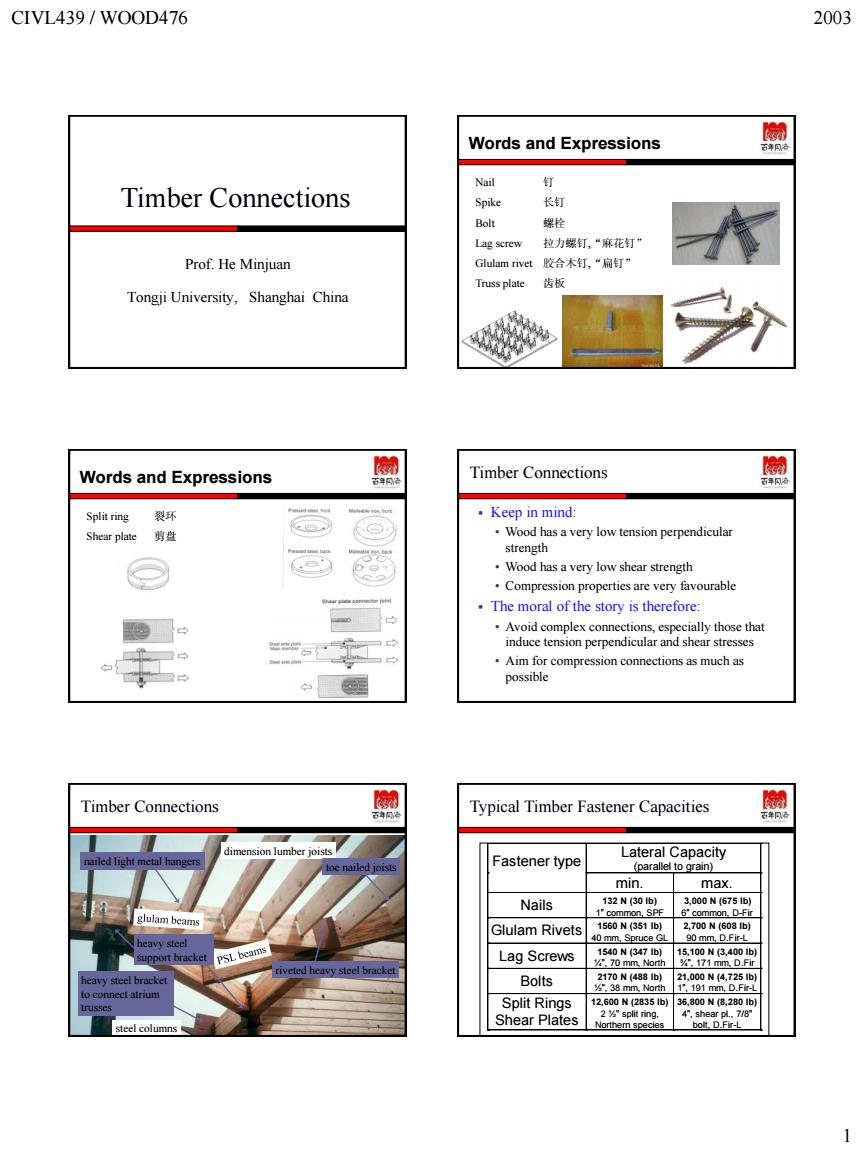
CIVL439/WOOD476 2003 Words and Expressions Nail 钉 Timber Connections Spike 长钉 Bolt 棋栓 Lag screw拉力蝶钉,“麻花钉 Prof.He Minjuan Glulam rivet胶合木钉,“扇钉” Truss plate齿板 Tongji University,Shanghai China Words and Expressions 园 Timber Connections Split ring裂环 .Keep in mind Shear plate约盘 Wood has a very low sheat streneth Compression properties are very favourable The moral of the story is therefore: Avoid complex com Timber Connections Typical Timber Fastener Capacities Fastener type Lateral Capacity Nails Glulam rivets Lag Screws Bolts Split Rings 1
CIVL439 / WOOD476 2003 1 Timber Connections Prof. He Minjuan Tongji University, Shanghai China Words and Expressions Nail 钉 Spike 长钉 Bolt 螺栓 Lag screw 拉力螺钉,“麻花钉” Glulam rivet 胶合木钉,“扁钉” Truss plate 齿板 Words and Expressions Split ring 裂环 Shear plate 剪盘 Timber Connections Keep in mind: • Wood has a very low tension perpendicular strength • Wood has a very low shear strength • Compression properties are very favourable The moral of the story is therefore: • Avoid complex connections, especially those that induce tension perpendicular and shear stresses • Aim for compression connections as much as possible Timber Connections steel columns dimension lumber joists heavy steel bracket to connect atrium trusses riveted heavy steel bracket toe nailed joists nailed light metal hangers heavy steel support bracket Typical Timber Fastener Capacities Fastener type Lateral Capacity (parallel to grain) min. max. Nails 132 N (30 lb) 1” common, SPF 3,000 N (675 lb) 6” common, D-Fir Glulam Rivets 1560 N (351 lb) 40 mm, Spruce GL 2,700 N (608 lb) 90 mm, D.Fir-L Lag Screws 1540 N (347 lb) ¼”, 70 mm, North 15,100 N (3,400 lb) ¾”, 171 mm, D.Fir Bolts 2170 N (488 lb) ½”, 38 mm, North 21,000 N (4,725 lb) 1”, 191 mm, D.Fir-L Split Rings Shear Plates 12,600 N (2835 lb) 2 ½” split ring, Northern species 36,800 N (8,280 lb) 4”, shear pl., 7/8” bolt, D.Fir-L
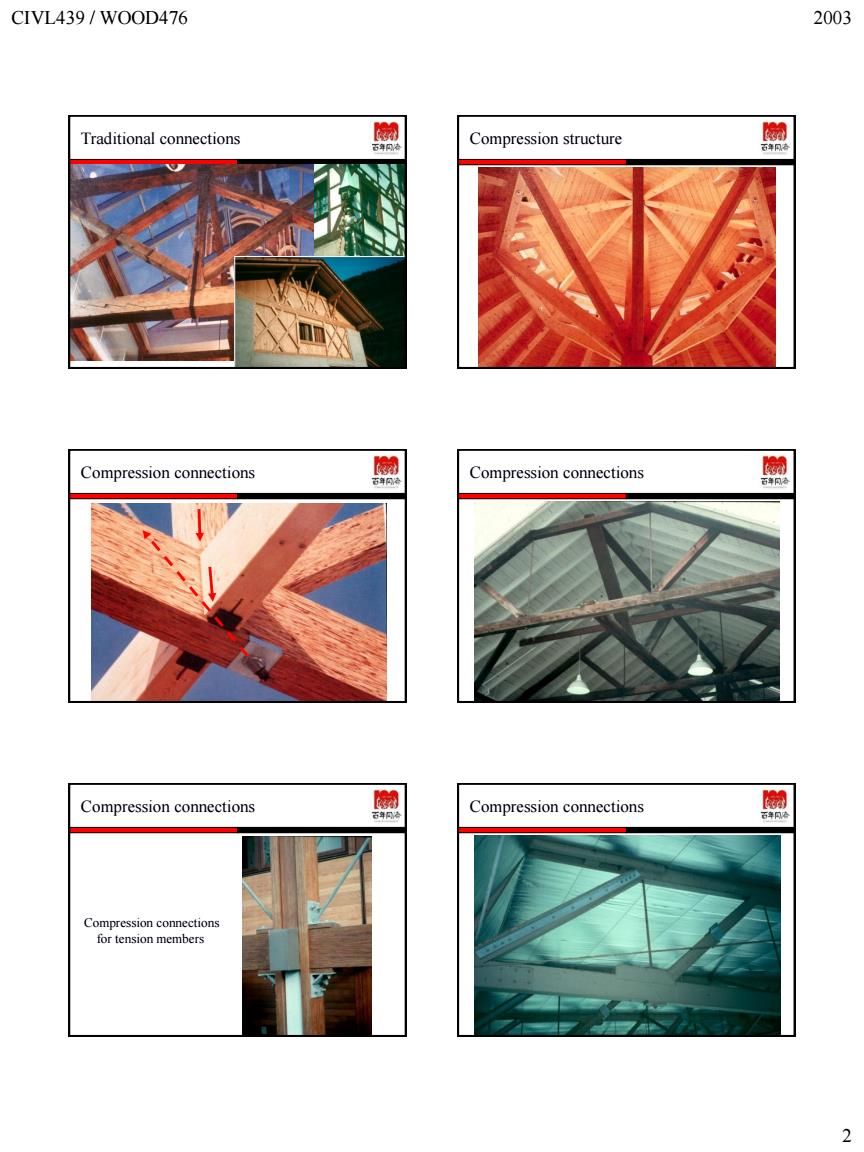
CIVL439/WOOD476 2003 Traditional connections Compression structure Compression connections Compression connections Compression connections Compression connections
CIVL439 / WOOD476 2003 2 Traditional connections Compression structure Compression connections Compression connections Compression connections Compression connections for tension members Compression connections

CIVL439/WOOD476 2003 Compression connections Beam on column support The onnector-less Beam on column support Face mounted beam hangers with timber rivets tohe Saddle beam hangers Bolted beam supports ■ 3
CIVL439 / WOOD476 2003 3 Compression connections The connector-less connection Beam on column support Compression perpendicular to grain stresses Assure adequate bearing area Simple beam supports Beam on column support Use a hardwood block to reduce bearing stresses Face mounted beam hangers with timber rivets notch Compression perpendicular to grain Saddle beam hangers seat saddle Bolted beam supports
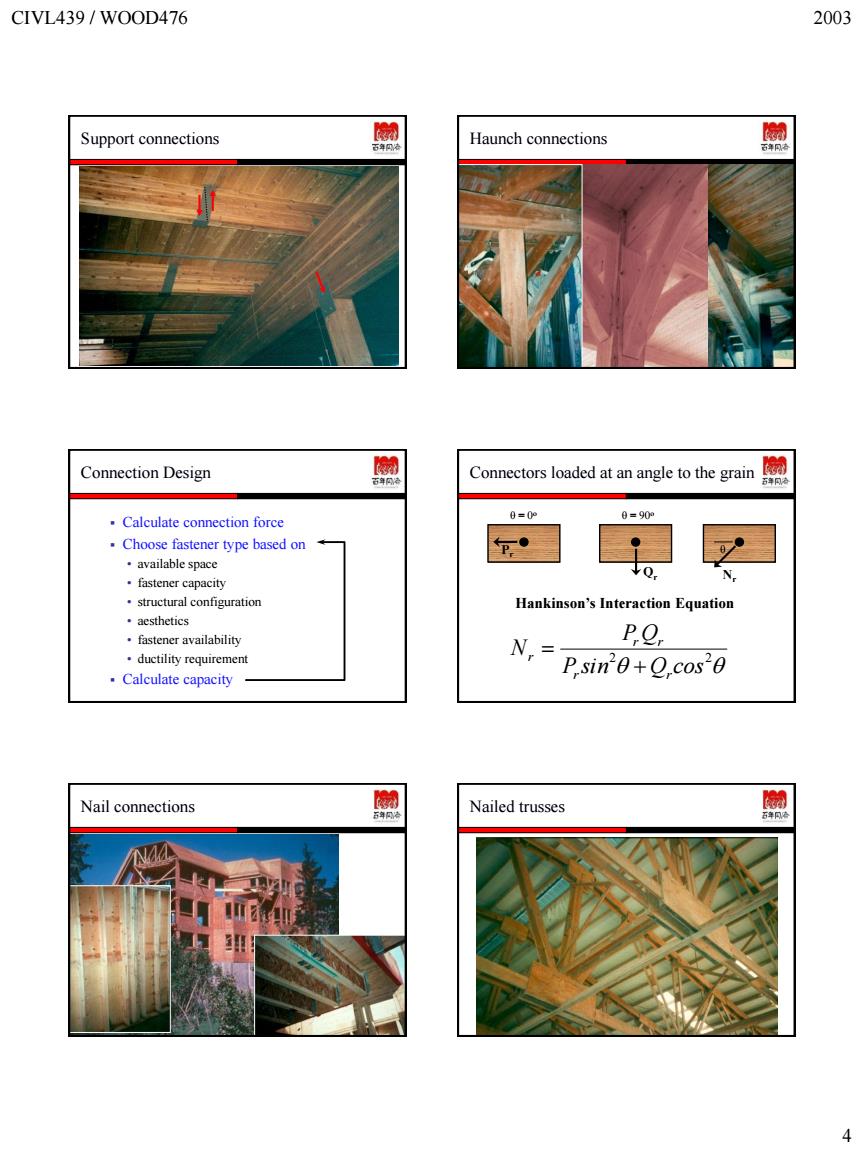
CIVL439/WOOD476 2003 Support connections Haunch connections Connection Design 胞 Connectors loaded at an angle to the grain Calculate connection force 90 0 fast Hankinson's Interaction Equation .fastener availability N,= PO. .ductility requirement ·Calculate capacity Psin0+O.cos20 Nail connections Nailed trusses 4
CIVL439 / WOOD476 2003 4 Support connections Haunch connections Connection Design Calculate connection force Choose fastener type based on • available space • fastener capacity • structural configuration • aesthetics • fastener availability • ductility requirement Calculate capacity Connectors loaded at an angle to the grain 2 2 P sin Q cos P Q N r r r r r Pr Qr Nr θ Hankinson’s Interaction Equation θ = 90o θ = 0o Nail connections Nailed trusses

CIVL439/WOOD476 2003 Nails and Spikes Connection Configuration Most common fastener Widely used in Wood Frame Construction .Easy to install No pre-drilling (careful splitting!) Ductile connection-no group effect Efficientespecially with panel products Bolted connections Bolted connections 园 ield model Du 0c Displacement Bolted connections 园 Brittle failure modes Bolt failure modes-Johansen Yield Model Avoid britte failure modes by following spacing rue 库华好5 >7 帝华平
CIVL439 / WOOD476 2003 5 Nails and Spikes Most common fastener Widely used in Wood Frame Construction Easy to install No pre-drilling (careful splitting!) Ductile connection - no group effect Efficient - especially with panel products Limited by spacing requirements (2 times crack growth length) Connection Configuration loaded end distance spacing edge distance row spacing no. of rows …and other parameters Bolted connections Bolted connections Based on ultimate capacity Quantified by Johansen yield model Ductility depends on bolt slenderness, spacing, end distance Load Displacement Slender bolts Stocky bolts Bolted connections Brittle failure modes Avoid brittle failure modes by following spacing rules: loaded end distance > 7d (preferably > 10d) Spacing > 4d edge distance > 1.5d row spacing > 2d Similar rules exist for perpendicular to grain loading

CIVL439/WOOD476 2003 Group effects Group effects in bolted connections 55℃ End distance effect Group effects in bolted connections Loaded end distance factor Row factor J=1.0 for e=10d Jg=1.0 for I row =0.75 for e=7d =0.8 for 2 rows(2or more bolts in row) Load -0.6 for 3 rows (2 or more bolts in row) 000 Displacement 000 Group effects Lag Screws Similar to single shear bolt connection Use Johansen yield model Penetration length main member thickness 6
CIVL439 / WOOD476 2003 6 Group effects Auditorium University of Northern BC Prince George Group effects in bolted connections Factor to account for no. of bolts in a row JG = 0.33 (l/d)0.5 (s/d)0.2 N-0.3 10d e = 10d e = 7d Group effects in bolted connections Row factor JR = 1.0 for 1 row = 0.8 for 2 rows (2 or more bolts in row) = 0.6 for 3 rows (2 or more bolts in row) Group effects Lag Screws Similar to single shear bolt connection Use Johansen yield model • Penetration length = main member thickness Also have substantial withdrawal resistance (Prw)

CIVL439/WOOD476 2003 Split Rings and Shear Plates 脚 Split Rings and Shear Plates High strength fasteners splat ring Installation of Split Rings and Shear Plates Shear plate installation Installation special tool Load Splt Rings and Shear Plates Large split ring connections ◆Stress conditions ◆Failure mod 7
CIVL439 / WOOD476 2003 7 Split Rings and Shear Plates High strength fasteners • Provide larger grip surface on wood Wood failure modes typical shear plates split ring Split Rings and Shear Plates Installation of Split Rings and Shear Plates Installation: • special tools • tight fit • ideal for pre-fabrication Shear plate installation Load transfer with Split Rings and Shear Plates Large split ring connections

CIVL439/WOOD476 2003 Large split ring connections Analysis of split ring connection ote:Split rings can carry loa Applications for split rings and shear plates Example of a shear plate connection 骨 Ridge connection with split ring Glulam Rivets Special nail High strength Wedged head (fixed head,force double cuv) 0 8
CIVL439 / WOOD476 2003 8 Large split ring connections Shear plate connection Glulam Rivet connections Lag screw for positioning Analysis of split ring connection Note: Split rings can carry loads at different angles to grain. Shear plates always carry loads in the same direction as the member load Applications for split rings and shear plates Example of a shear plate connection Ridge connection with split ring Glulam Rivets High strength nailed connection for heavy timber construction Special nail • High strength (high capacity) • Oval cross-section (less splitting, tight spacing) • Steel side plates (better load distribution) • Wedged head (fixed head, force double curv)
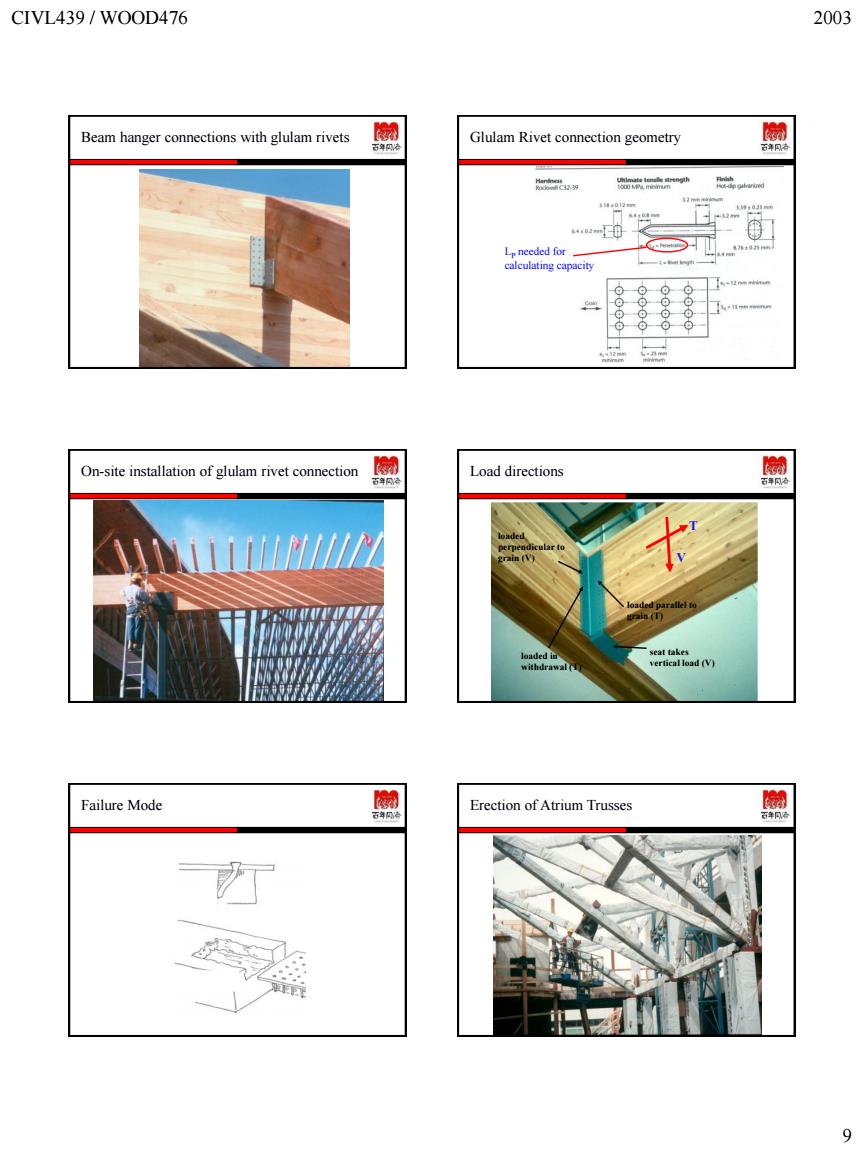
CIVL439/WOOD476 2003 Beam hanger connections with glulam rivets Glulam Rivet connection geometry 8888 8888 On-site installation of glulam rivet connection 园 Load directions d(V Failure Mode Erection of Atrium Trusses 9
CIVL439 / WOOD476 2003 9 Beam hanger connections with glulam rivets Glulam Rivet connection geometry LP needed for calculating capacity On-site installation of glulam rivet connection Load directions loaded perpendicular to grain (V) loaded parallel to grain (T) loaded in withdrawal (T) seat takes vertical load (V) T V Failure Mode Erection of Atrium Trusses
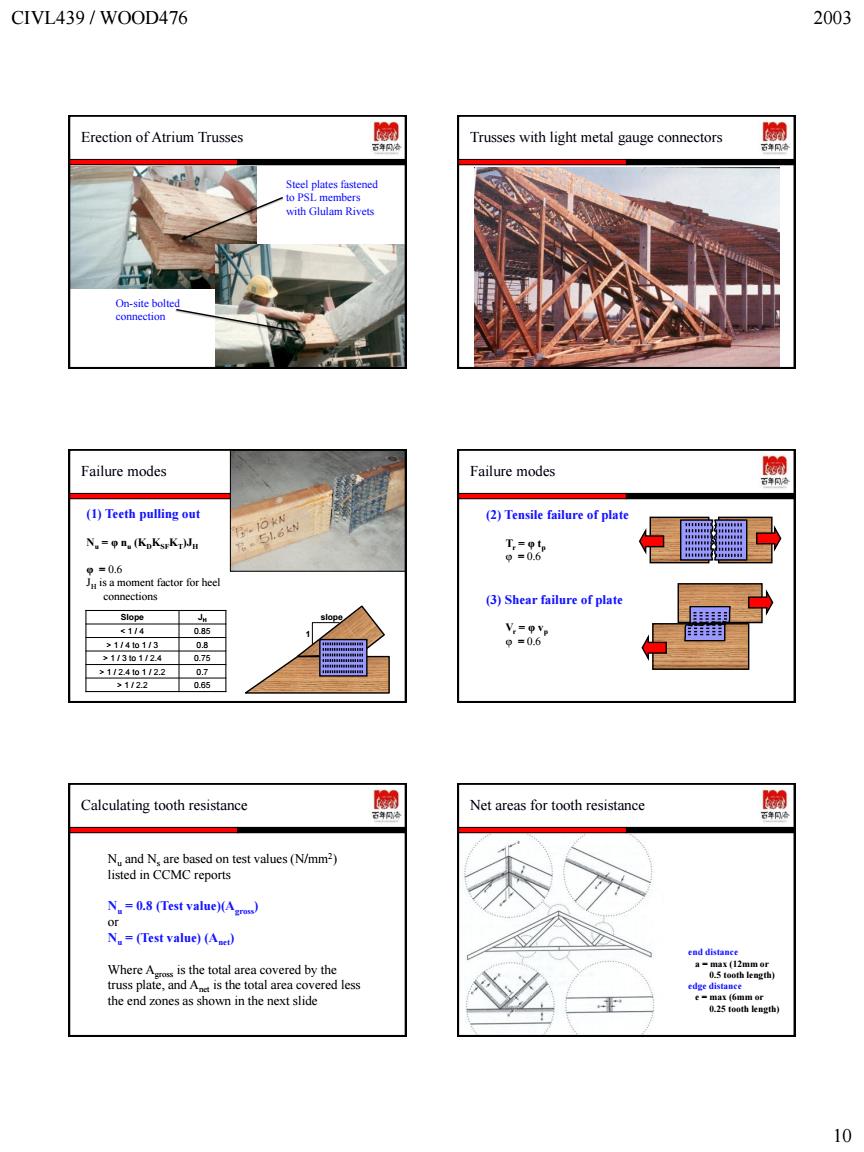
CIVL439/WOOD476 2003 Erection of Atrium Trusses Trusses with light metal gauge connectors with Glulam Rivet Failure modes Failure modes 2)Tensile failure of plate N.-on.(KpKsrK:)u 58 06 t factor for hee 3)Shear failure of plate 。5 86 1/41 065 Calculating tooth resistance Net areas for tooth resistance N=0.8(Test value)(A) d less 10
CIVL439 / WOOD476 2003 10 Erection of Atrium Trusses Steel plates fastened to PSL members with Glulam Rivets On-site bolted connection Trusses with light metal gauge connectors Failure modes (1) Teeth pulling out Nu = φ nu (KDKSFKT )JH φ = 0.6 JH is a moment factor for heel connections 1 Slope JH slope 1 / 4 to 1 / 3 0.8 > 1 / 3 to 1 / 2.4 0.75 > 1 / 2.4 to 1 / 2.2 0.7 > 1 / 2.2 0.65 Failure modes (2) Tensile failure of plate Tr = φ tp φ = 0.6 (3) Shear failure of plate Vr = φ vp φ = 0.6 Calculating tooth resistance Nu and Ns are based on test values (N/mm2 ) listed in CCMC reports Nu = 0.8 (Test value)(Agross) or Nu = (Test value) (Anet) Where Agross is the total area covered by the truss plate, and Anet is the total area covered less the end zones as shown in the next slide Net areas for tooth resistance end distance a = max (12mm or 0.5 tooth length) edge distance e = max (6mm or 0.25 tooth length)